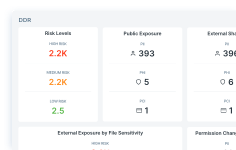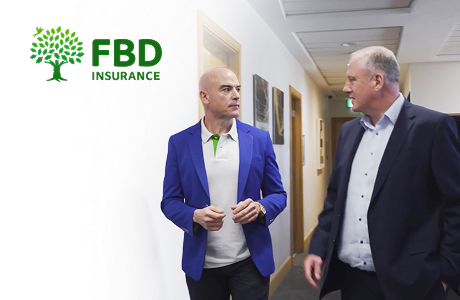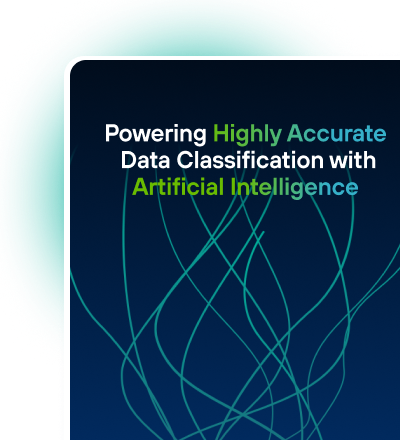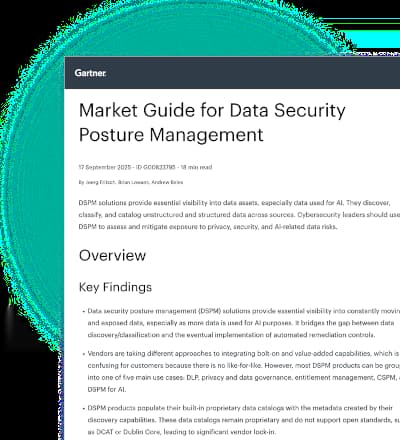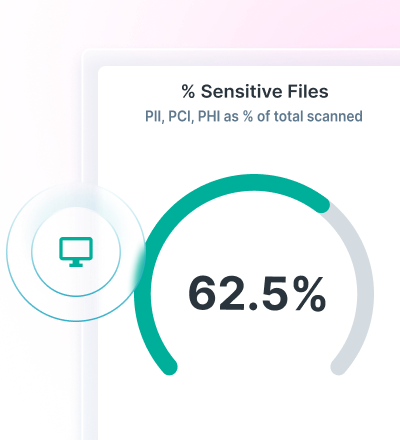The 2025 Data Loss Prevention Guide: Prevent Data Loss Anywhere
0 min read

Brandon Keller
1. Introduction: What You Need to Know About DLP in 2025
Sensitive data is the lifeblood of every organization, which includes but isn’t limited to customer records, source code, M&A plans, regulated PII, PHI and intellectual property. With hybrid work, generative AI and SaaS sprawl, the traditional perimeter is gone. Forcepoint Data Loss Prevention (DLP) is no longer optional. It’s the foundation for getting superior visibility and control over your data. This guide distills lessons from thousands of Forcepoint deployments to help you protect data everywhere it lives and moves.
2. What is Data Loss Prevention?
Data Loss Prevention (DLP) refers to a set of technologies and strategies designed to prevent sensitive data from being lost, misused or accessed by unauthorized users.
Forcepoint DLP protects data in motion, at rest and in use across endpoints, networks and cloud environments to ensure your critical information stays protected. Our solution combines advanced analytics and policy enforcement to help stop data breaches.
2.1 States of Data
Below is a brief overview of a few states of data and how DLP can apply to them.
| State | Example | DLP Focus |
| Data in Use | Copy/paste, screen capture, printing | Endpoint controls, user behavior analytics |
| Data in Motion | Email, SaaS uploads, web posts | Network & cloud inspection, encryption, blocking |
| Data at Rest | File servers, SharePoint, OneDrive | Discovery, classification, remediation |
3- Why Organizations Invest in DLP
Below are a few reasons why organizations invest in DLP.
- Regulatory Compliance: GDPR, CCPA, HIPAA, PCI‑DSS, and more.
- Intellectual Property (IP) Protection: Safeguard trade secrets and R&D
- Insider Threat Mitigation: Detect risky behavior before data walks out the door.
- Cloud & SaaS Governance: Maintain visibility as data moves to Microsoft 365, Google Workspace and beyond.
- Incident Cost Reduction: DLP helps reduce incident frequency and scope.
4- How DLP Works: Discovery, Monitoring & Enforcement
DLP works by using multiple tools to identify sensitive information within an IT environment, monitor data flow in and out of the organization and block sensitive data from leaving the organization based on security policies. See more information in the table below.
| Phase | What Happens |
| Discover & Classify | Scan endpoints, servers, cloud stores for sensitive data; apply labels |
| Monitor & Detect | Monitor and block security incidents in real time wherever users interact with data |
| Enforce & Educate | Block, quarantine, encrypt or coach users |
5- Core Types of DLP
- 1- Network DLP monitors and controls data in motion across your network.
- 2- Endpoint DLP protects data on individual devices.3
- 3- Cloud DLP secures data stored in or moving through cloud services.
Forcepoint DLP unifies policy creation and enforcement across endpoint, network and cloud, giving you consistent protection and simplified management across your entire data ecosystem.
6- Key Capabilities to Look For
Below are some key capabilities to look for in DLP solutions.
| Capability | Why It Matters | Forcepoint Feature |
| Content Delivery | Detect PII, PCI, IP | 1,700+ pre-defined policy templates and classifiers, fingerprinting |
| Contextual Awareness | Location device, user role | Policies adapt dynamically with Risk-Adaptive Protection |
| User Behavior Analytics | Distinguish mistakes from malice | Risk-Adaptive Protection |
| Cloud Integration | SaaS visibility | Deploy Forcepoint DLP in the cloud (SaaS) or on-premises |
| Scalability | Global coverage | Forcepoint DLP is designed to integrate seamlessly with existing IT infrastructure and scale to meet the needs of large organizations |
| Data-in-Motion Protection | Secure transfers | Forcepoint DLP protects data at rest, in motion, and in use across all environments |
7- Forcepoint Risk‑Adaptive Protection Advantage
Traditional DLP fires the same rule every time. Forcepoint Risk-Adaptive Protection monitors user behavior and adjusts policies automatically to keep up with ever-changing threats, then automatically steps up or down controls.
7.1 Increase Productivity
Forcepoint DLP can use risk-adaptive protection to automatically adjust security policies based on user behavior, minimizing disruptions and allowing employees to work more efficiently.
8- Common Data Loss Scenarios & Use Cases
Here is a summary of some commons data loss scenarios and how DLP can provide value to protect data.
| Scenario | DLP Use Case |
| Prevent Data Breaches | DLP solutions help detect and prevent unauthorized access, use or transfer of sensitive data, reducing the risk of data breaches |
| Protect Intellectual Property | By monitoring and controlling the flow of sensitive information, DLP helps safeguard intellectual property such as trade secrets, product designs and proprietary research |
| Ensure Regulatory Compliance | DLP assists in complying with various regulations like GDPR, HIPAA and PCI DSS by ensuring that sensitive data is handled according to legal requirements |
| Secure Data in GenAI Applications | DLP helps protect sensitive data when using Generative AI websites or applications by monitoring and controlling data inputs and outputs, ensuring that confidential information is not inadvertently shared or exposed |
9- Deployment: In the Cloud or On-Premises
Forcepoint DLP can be deployed in the cloud (SaaS) or on-premises. With implementation support from the Forcepoint professional services team, your organization can see time-to-value in as few as six weeks.
10- Ten Best Practices for a Successful DLP Program
- 1- Secure Executive Sponsorship: Align DLP with business outcomes.
- 2- Start With Discovery: You can’t protect what you don’t know.
- 3- Prioritize Crown Jewels: Classify data by value and risk.
- 4- Use Risk‑Adaptive Policies: Reduce false positives and user friction.
- 5- Roll Out in Phases: Monitor→ warn → enforce.
- 6- Integrate With IAM & SIEM: Context and visibility accelerate response.
- 7- Educate Users Continuously: In‑line coaching turns mistakes into learning.
- 8- Measure & Iterate: Track incident trends, dwell time and policy hits.
- 9- Automate Where Possible: SOAR, ticketing and auto‑remediation.
- 10- Plan for the Future: Control how sensitive data is shared with ChatGPT and other generative AI platforms.
11- Implementation Roadmap Example
| Phase | Potential Timeline Example (timelines may differ by company) |
| Scope and Project Initiation | Week 1-2 and 3-4 |
| Review Current Environment | Week 2 - 4 |
| Installation and Configuration | Week 3 - 4 |
| Phased Deployment | Week 4 - 5 |
| Monitoring and Testing | Week 4 - 6 |
| Knowledge Transfer | Week 5 - 6 |
You should base your timeline on your assessment of your available resources and project needs. Each deployment will call for a different amount of time, but we have supported successful DLP SaaS deployments in as few as six weeks.
Read The Practical Executive’s Guide to Data Loss Prevention from Forcepoint to learn more.
12- Measuring Success: Metrics & KPIs
- Incident Reduction Rate: Monitor the reduction in data exfiltration attempts by tracking blocked events across email, cloud apps, endpoints and successful prevention of data breaches.
- False‑Positive Rate: Track the effectiveness of DLP in reducing false positives.
- Global Privacy Compliance: Evaluate the time and resources saved on compliance by using pre-built templates for over 160 regions, tracking audit preparation time and associated costs.
- Data Protection Regulations: Monitor ease of maintaining GDPR, CCPA and other regulatory compliance by tracking audit pass rates and reductions in compliance-related incidents.
13- FAQ: Your Top DLP Questions Answered
Q1. Does DLP slow down productivity?
By consolidating data security policies across various channels (e.g., endpoints, networks, cloud apps), Forcepoint DLP simplifies unified policy management, reducing complexity and time required for management, which leads to increased productivity and operational cost savings.
Q2. Do organizations need DLP?
Absolutely. If your organization handles Personally Identifiable Information (PII), Protected Health Information (PHI), Payment Card Information (PCI), intellectual property or operates in a BYOD environment, DLP is essential. Forcepoint DLP helps you prevent accidental leaks, insider threats and external attacks while protecting your brand, customers and bottom line.
Q3. Can Forcepoint protect data in generative AI tools?
Yes. DLP can prevent sensitive information from being pasted into prompts or outputs from leaving your environment through email.
14- Conclusion & Next Steps
Data Loss Prevention is essential for modern security, but not all DLPs are created equal. Forcepoint DLP delivers unified visibility, adaptive control and automated protection across all your critical channels, backed by two decades of leadership in data security and the trust of enterprises around the world. Ready to see it in action?
Request a free data risk assessment to discover your hidden data on OneDrive.
Protect data everywhere it lives, without slowing your business.

Brandon Keller
Read more articles by Brandon KellerBrandon is a Multimedia Content Marketer, driving content strategy and development across Forcepoint platforms. He applies his enterprise marketing experience to help organizations adopt industry-leading security solutions.
- The Practical Guide to Mastering Data Compliance
In the Article
 The Practical Guide to Mastering Data ComplianceRead the eBook
The Practical Guide to Mastering Data ComplianceRead the eBook
X-Labs
Get insight, analysis & news straight to your inbox

To the Point
Cybersecurity
A Podcast covering latest trends and topics in the world of cybersecurity
Listen Now
